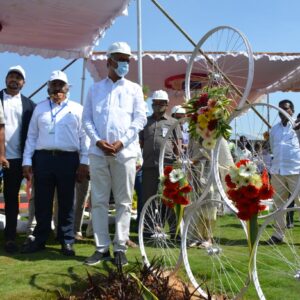India needs to re-imagine its approaches to waste management and Telangana, has a great opportunity to lead such a re-imagination. Traditionally, India has attempted to borrow its sanitation approaches largely from the developed western nations and its immaculate (clean & tidy) cities. In recent years however, new ideologies are beginning to take root. Today, there is greater acceptance towards low power and robust ecological treatment technologies, greater appreciation for more cost-effective decentralised systems and lesser fascination for western state of the art
technologies.
There is no other way to reach our goal of Sanitation for all, than by adopting systems that are low on capital & operating costs. Otherwise they would be economically un-sustainable for a significant part of the population in our country. This surely points towards a greater emphasis on treating the faecal sludge as close to the source as possible. Thus well-designed, well-constructed, robust, efficient onsite, community scale systems are an important part of the solution. It also points to more ecological (or environmentally sustainable) methods of treatment that are low in power consumption, requiring negligible operator intervention and skills. It also points to the importance of re-use of all the products and bi-products of treated sewage, as a way of making the overall system very cost-effective. It also points to the importance of shared infrastructure as a way of reducing costs – shared conveyance systems, co-composting, co-treatment and the like. The waste generation in India has increased sharply owing to rapid population growth and urbanization over the past couple of decades. Though the number of people in India practicing open defecation has marginally reduced the management of onsite sanitation facilities such as septic
tanks and pits remain a neglected component of provision of safe sanitation facilities. Faecal sludge is a fluid mixture of untreated and partially treated sewage solids, liquids and sludge of human or domestic origin. In other words, faecal sludge is sludge from onsite sanitation systems that is a combination of raw primary sludge and anaerobically digested sludge. Generally, faecal sludge has three main components as follows:
- Scum – floats on top and is generally where the living bacteria treat the waste
- Effluent – the semi-treated liquid that comprises the majority of the material in the septic
tank - Sludge – solids which collect at the bottom of the tank
The physio-chemical characteristics of the faecal sludge can vary depending on the characteristics namely the size and type of onsite sanitation system, design, desludging interval and the local climatic conditions of the place where the tank is located, the quantity and quality of water supplied and the type of wastewater originating from the household (which is user specific). Faecal sludge when not managed properly can cause pollution of waterways including groundwater. Such situations have serious implications on health and environment. It was projected that by 2015, the proportion of urban Indian population with access to improved sanitation facilities will increase to 80% (from 43% in 1990) and for rural population, the projection is 48% (from 1% in 1990). As per projections made by United States Agency for International Development in 2010, by 2017 it is expected that 148 million urban population in the country would have septic tanks and about 425 million rural population would have gained access to improved sanitation facilities. Thus, it is clear that the number of onsite sanitation systems will only grow over the next few years. Though faecal sludge management poses a national problem, it can also be viewed as a potential resource. When properly managed, faecal sludge can rather be a useful resource than a waste. Faecal sludge contains plant nutrients such as nitrogen and phosphorous which is contributed by human urine and faeces. Faecal sludge can reduce reliance on chemical fertilizers, and when combined in adequate amounts with fertilizers can provide the required nutrients for crop production.
The majority of onsite sanitation systems such as septic tanks and pits require frequent desludging which should be in accordance with the design and capacity of the system as well as environmental aspects such as the ground water level and the soil type. Usually, desludging takes place only when there is blockage, odour and overflow of the contents from the tanks. The overflow of the tank finds its way into the nearest waterways and pollutes it. Faecal sludge, which is rich in nutrients such as nitrogen and phosphorous, disposed untreated into surface water bodies, would pose a threat of eutrophication. Furthermore faecal sludge contains solids which float or sink to the bottom
impacting the ecosystem, organic matter which depletes oxygen in water bodies as well as pathogens possibly causing diseases. The adequate facilities and services for collection, transportation, treatment and disposal of urban
domestic faecal sludge are non-existent in majority of Indian cities. Most onsite sanitation systems (OSS) are emptied manually in absence of suitable equipment by scavengers. Ideally a septic tank system should be desludged regularly every 2-5 years. But ignorance towards Operation and Maintenance (O&M) procedures often results in accumulation of sludge at the bottom reducing the effective tank volume which leads to an overflow or to a blockage of the soak pit. This sequence of events ultimately causes failure of the system and release of partially treated or untreated faecal sludge from the septic tank. Private cesspool vehicle operators often do not transport and dispose of faecal sludge several kilometres away from human settlements or in a Sewage Treatment Plant (if existing) and instead dump it in drains, waterways, open land, and agricultural fields.






























